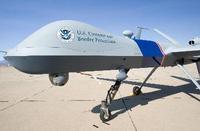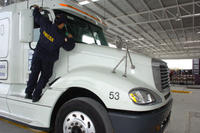-
Congress plans to use credit rating to verify American workers
The federal government is exploring the possibility of using a credit rating giant like Equifax to verify the identity of American workers, a move that could make it far more difficult for undocumented immigrants to get work using stolen Social Security numbers
-
-
Border agent seizes student's laptop without warrant
On 1 May when a U.S. Customs and Border Protection agent stopped Pascal Abidor, an Islamic studies doctoral student at McGill University in Montreal, at Champlain, New York’s port of entry; the agent turned on Abidor’s computer and found a picture of a rally by the Hamas militant group, something he had downloaded from the Internet for schoolwork; Abidor’s life has not been the same since
-
-
Border agents intercept "destructive" Pakistani insects in Oakland
The Khapra beetle, which is native to India, can eat its way through up to 70 percent of grain stores to which it has access; it was eradicated in the United States in 1966, and has been subject to federal quarantine since then; U.S. border agents in the Port of Oakland discover — and destroy — the larva in a shipment from Pakistan
-
-
Mark Krikorian, executive director of the Center for Immigration Studies
Mark Krikorian, the executive director of the Center for Immigration Studies, was interviewed by Homeland Security NewsWire’s executive editor, Eugene Chow; Krikorian discusses the Obama administration’s immigration strategy, why mass migration is an outdated phenomenon, and what the government can do to enforce immigration laws effectively; “make E-Verify mandatory,” he says
-
-
DHS probes dancers for visas
It was a close call for the East Village theater La MaMa: At least three weeks’ worth of box-office revenue was on the line when DHS questioned the visa applications submitted by artists in an upcoming performance; although delayed by one week, the show will go on: The Irish Modern Dance Theatre’s “Fall and Recover,” a dance work inspired by survivors of torture, now opens Friday 25 March
-
-
E-Verify Self Check launched
DHS and U.S. Citizenship and Immigration Services (USCIS) announced the launch of E-Verify Self Check — a service that allows individuals in the United States to check their own employment eligibility status before formally seeking employment
-
-
Canada blasts DHS plan to impose a $5.50 border fee on Canadians
A $5.50 border fee proposed for the 2012 budget would net millions for the American coffers, funding security measures; DHS is calling for the change, and analysts predict the increase in collections could bring in up to $110 million dollars; Canadian Foreign Affairs officials have blasted the fee
-
-
U.S. UAVs track drug gangs in Mexico

The war in Mexico — between the drug cartels and the government, and among the drug cartels themselves — has been increasingly spilling across the border into the United States; some cartels now maintain outposts in the Arizona desert; to gather more information about the cartels, and to help the Mexican authorities in their war against them, the United States has been flying unarmed surveillance UAVs over Mexico; the flights are made in coordination with and at the request of the Mexican government; the Mexican authorities also choose the target of drone surveillance; drones had gathered intelligence that led to the arrest in Mexico of several suspects in connection with the murder of a U.S. immigration agent, Jaime Zapata
-
-
Monitoring Mexican trucks operating in the U.S.

The U.S. plan to equip Mexican trucks with electronic recorders for driver logs would be a limited, temporary program undertaken because it is the only way the Federal Motor Carrier Safety Administration (FCMSA) can ensure that the Mexican trucks will be monitored, the U.S. government says; under (NAFTA), the United States cannot require Mexican carriers to do anything that U.S. carriers are not required to do, but the government still must provide a way to monitor Mexican carriers for compliance with both the hours of service rules and the cabotage rules that restrict freight hauling between points in the United States
-
-
Auditor faults SBInet's successor
A federal auditor has found that DHS has not provided evidence that their plan to integrate surveillance technologies across the nation’s southern border will be more practical and cost-efficient than the failed $1.5 billion virtual fence the project is supposed to replace; GAO as well as security and technology experts, say the substitute plan closely resembles the original project that wasted hundreds of millions of dollars and years of work on tools that malfunctioned in the severe heat
-
-
Sector Report for Thursday, 10 March 2011: Border / Immigration control
This report contains the following stories.
Plus 1 additional story.
-
-
Effort to stem flow of firearms to Mexico backfires

There are no limits in the United States to the number of long guns (as opposed to pistols or revolvers) a person is allowed to buy; the Mexican drug cartels exploited this buy sending thousands of straw buyers to gun shows an gun shops to buy hundreds of thousands of fire arms, then smuggle them to Mexico; to stem the flow of guns, the ATF launched Project Gunrunner: rather than just take down low-level straw buyers here and there, the agency hoped that by “letting the guns walk,” the sales would lead investigators to cartel members higher up in the organization; insiders say it never did; ATF could have told gun owners not to sell, or later seize the guns in an arrest; instead, gun store owners were allowed to sell even though agents often knew the buyer was a straw for the Mexican cartels; those guns can be traced to hundreds of robberies, rapes, and murders; experts said the numbers are much higher
-
-
Border agents struggle with Canadian border
As more attention and resources are poured into the U.S.-Mexico border, U.S. Border Patrol agents along the northern border have struggled with limited resources and manpower; the nearly 4,000 mile U.S.-Canada border is roughly twice as long as the southern border, yet there are only 2,200 agents posted along it compared to 18,000 agents in the south; Border Patrol agents in the north say they lack the resources to do the job; smuggling rings, especially drug traffickers, exploit the gaps in security along the northern border to ship large quantities of drugs to the United States
-
-
Mexican trucks set to cross border again

President Obama and Mexican president Felipe Calderon have struck a deal that will allow Mexican trucks to cross the border once again; the new deal will end a sixteen year dispute which has effectively kept Mexican tractor-trailers from driving on U.S. roadways; the plan will allow an unlimited flow of trucks from Mexico to enter the United States so long as shipping companies register the vehicles, pass inspections, and do not break safety regulations; the new agreement could generate as much as $675 million in cost savings; each year there are roughly 4.5 million truck crossings and each crossing cost $150; last year more than $2.75 billion in goods travelled across the border
-
-
Rep. King, CBP commissioner, Nassau County executive discuss borders

A high-level meeting took place in Mineola, Long Island, earlier this week between among Representative Pete King, chairman of the House Committee on Homeland Security, Alan Bersin, commissioner, U.S. Customs & Border Protection, Edward Mangano, Nassau County executive; a spokesperson said the meeting was about the Federal government’s efforts to make U.S. borders safe while working to promote commerce and trade
-
- All
- Regional
- Water
- Biometrics
- Borders/Immig
- Business
- Cybersecurity
- Detection
- Disasters
- Government
- Infrastructure
- International
- Public health
- Public Safety
- Communication interoperabillity
- Emergency services
- Emergency medical services
- Fire
- First response
- IEDs
- Law Enforcement
- Law Enforcement Technology
- Military technology
- Nonlethal weapons
- Nuclear weapons
- Personal protection equipment
- Police
- Notification /alert systems
- Situational awareness
- Weapons systems
- Sci-Tech
- Sector Reports
- Surveillance
- Transportation
Advertising & Marketing: advertise@newswirepubs.com
Editorial: editor@newswirepubs.com
General: info@newswirepubs.com
2010-2011 © News Wire Publications, LLC News Wire Publications, LLC
220 Old Country Road | Suite 200 | Mineola | New York | 11501
Permissions and Policies
Editorial: editor@newswirepubs.com
General: info@newswirepubs.com
2010-2011 © News Wire Publications, LLC News Wire Publications, LLC
220 Old Country Road | Suite 200 | Mineola | New York | 11501
Permissions and Policies
